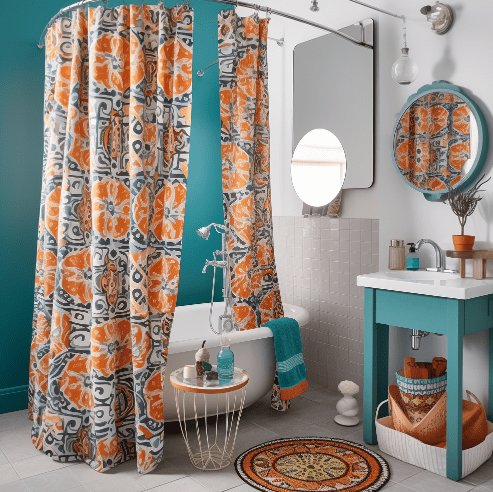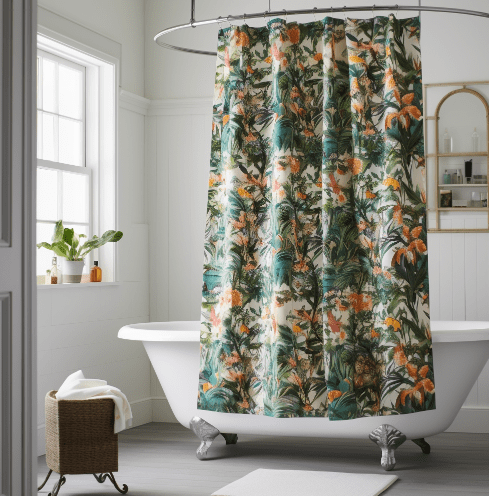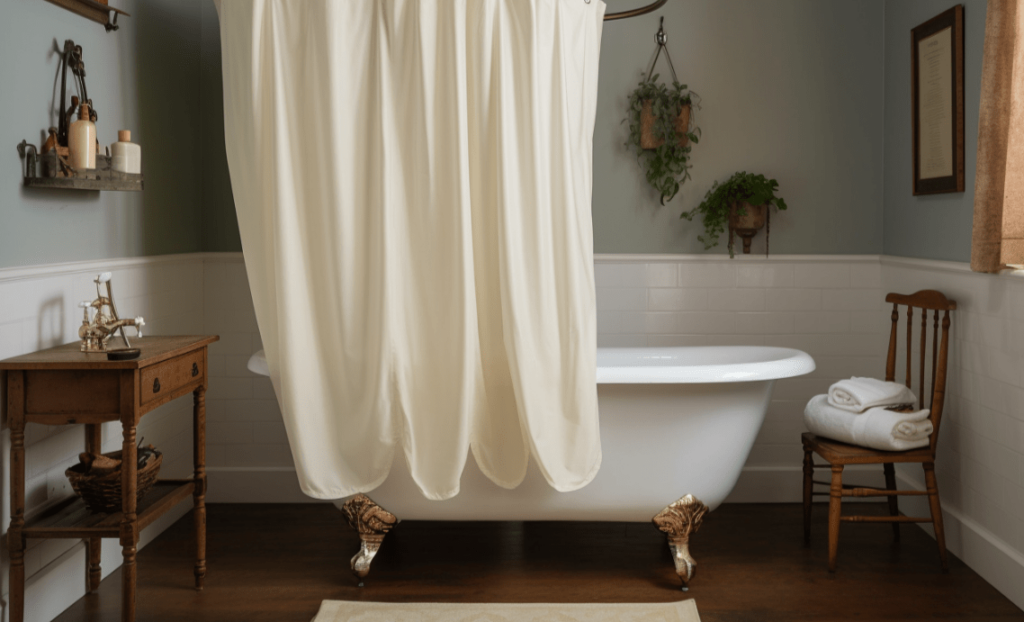A clawfoot tub is a timeless addition to any bathroom, offering a touch of vintage elegance and luxury. However, one common challenge that comes with owning a clawfoot tub is figuring out how to effectively enclose it for use as a shower. This guide will provide you with a comprehensive walkthrough on how to do just that.
Determining If Wall or Ceiling Mounted is Best
Before you can begin the process of enclosing your clawfoot tub, you’ll need to decide which type of shower rod is best for your specific situation: a wall-mounted or ceiling-mounted shower rod. Both types of rods serve the same purpose: to hold up a shower curtain that fully encloses your tub, preventing water from splashing out during showers and providing a sense of privacy. However, even though they accomplish the same goal, your bathroom arrangement may make one rod more ideal than the other. Here are some things to consider in that regard:
- Tub Placement: If your clawfoot tub is placed against one or two walls, a wall-mounted shower rod might be the most practical choice. However, if your tub is located in the middle of the room or away from the walls, a ceiling-mounted rod would likely be the better option.
- Wall and Ceiling Material: The material of your walls and ceiling can also influence your decision. For example, if you have tiled walls, drilling into them to install a wall-mounted rod can be challenging and potentially damaging. In such a case, a ceiling-mounted rod might be easier to install. Conversely, if you have a high or vaulted ceiling, a wall-mounted rod might be more practical.
- Bathroom Layout and Size: If your bathroom is small or has a unique layout, you might have limited options for where to install the shower rod. For instance, in a narrow bathroom, a wall-mounted rod might be the only feasible option.
- Aesthetic Preferences: Some people prefer the look of one type of rod over the other. For example, a ceiling-mounted rod can give your bathroom a more open and airy feel, while a wall-mounted rod can look more traditional and cozy. Even your idea for your shower curtain can make a big difference on which option you choose.
In terms of cost, both types of rods can range significantly in price depending on the specific product and brand. A wall-mounted shower rod can cost anywhere from $50 to $200, while a ceiling-mounted rod can range from $75 to $250. Remember, these are rough estimates and actual costs can vary based on where you live and where you shop. Always do your own research and get multiple quotes before making a purchase.
How to Enclose Your Clawfoot Tub Using a Wall-Mounted Shower Rod

If you’ve chosen to enclose the tub by using a wall-mounted shower rod, you’ll need the following materials:
| Material | Cost |
|---|---|
| Wall-Mounted Shower Rod (also called “fixed” rod) | $50 – $200 |
| Anchors and Screws (if not included) | $5 – $15 |
| Drill (if not already owned) | $30 – $100 |
| Level (if not already owned) | $10 – $30 |
| Shower Curtain Rings | $5 – $20 |
| Shower Curtain | $20 – $100 |
| Total | $120 – $465 |
Once you have your materials, follow these steps:
- Measure your tub and mark where the rod’s brackets will be installed on the wall.
- Drill holes in the wall at the spots you’ve marked. Use a drill bit that’s appropriate for your wall material.
- If your walls are drywall, install anchors. If they’re a solid material like tile or wood, you can skip this step.
- Screw the rod’s brackets into the holes you’ve drilled in the wall. Make sure they’re secure and level.
- Attach the rod to the brackets according to the manufacturer’s instructions. This usually involves sliding the rod into the brackets and tightening a set screw to hold it in place.
- Slide the curtain rings onto the rod before you install it, and then attach the shower curtain to the rings.
How to Enclose Your Clawfoot Tub Using a Ceiling-Mounted Shower Rod

For a ceiling-mounted shower rod, you’ll need similar materials, with a couple exceptions:
| Material | Cost |
|---|---|
| Ceiling-Mounted Shower Rod | $75 – $250 |
| Anchors and Screws (if not included) | $5 – $15 |
| Drill (if not already owned) | $30 – $100 |
| Level (if not already owned) | $10 – $30 |
| Ladder (if not already owned) | $50 – $200 |
| Shower Curtain Rings | $5 – $20 |
| Shower Curtain | $20 – $100 |
| Total | $145 – $515 |
It’s also worth noting that you’ll likely need help with the installation of a ceiling-mounted rod. Personally, I would suggest getting a second person to help here. Otherwise, you run the risk of hurting yourself or improper installation that will cause you issues in the future.
Follow these steps for installation:
- Measure and Mark: Measure your tub and mark where the rod’s supports will be installed on the ceiling. Be sure to consider the height of the ceiling and the length of the shower curtain when deciding where to place the marks. Clawfoot tubs require much larger shower curtains, so check the dimensions of yours and measure the rod appropriately.
- Set Up Your Ladder: Position your ladder securely under the area where you’ll be working. Always follow safety guidelines when using a ladder, including not overreaching and having someone spot you if possible.
- Drill Holes: Using your drill, make holes in the ceiling at the spots you’ve marked. Be sure to use a drill bit that’s appropriate for your ceiling material.
- Install Anchors: If your ceiling is drywall or another hollow material, you’ll need to install anchors to ensure the supports are secure. If it’s a solid material like wood, you can skip this step.
- Attach Supports: Climb the ladder and screw the rod’s supports into the holes you’ve drilled in the ceiling. Make sure they’re secure and level.
- Install the Rod: Attach the rod to the supports according to the manufacturer’s instructions. This usually involves sliding the rod into the supports and tightening a set screw to hold it in place.
- Attach the Curtain Rings: Slide your curtain rings onto the shower rod before you attach the rod to the brackets. The number of rings you need will depend on the size of your shower curtain and the length of your rod, but typically, you’ll need about 12-15 rings.
- Hang the Shower Curtain: Finally, attach your shower curtain to the curtain rings. Make sure the curtain goes all the way around the tub to prevent water from splashing out.
Remember, the specifics of this process can vary depending on the type of shower rod you purchase and the layout of your bathroom. Always follow the manufacturer’s instructions when installing any new hardware.
Enclosing your clawfoot tub with a shower curtain not only enhances the functionality of your bathroom but also adds a touch of elegance and charm. While the process may seem daunting at first, with the right tools and a bit of patience, it’s a task that many homeowners can do successfully. Remember, the costs can vary depending on the specific products you choose and where you shop, so always do your research before making a purchase. Good luck!

Colby Armstrong
Colby Armstrong, born and raised in Vermont, is an inventive designer who developed a fascination for interior design and color coordination from a young age, influenced by his home decorator parents. An ardent hiker and nature enthusiast, Armstrong draws inspiration from natural elements and colors, incorporating them into his unique shower curtain designs.

